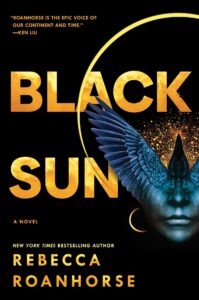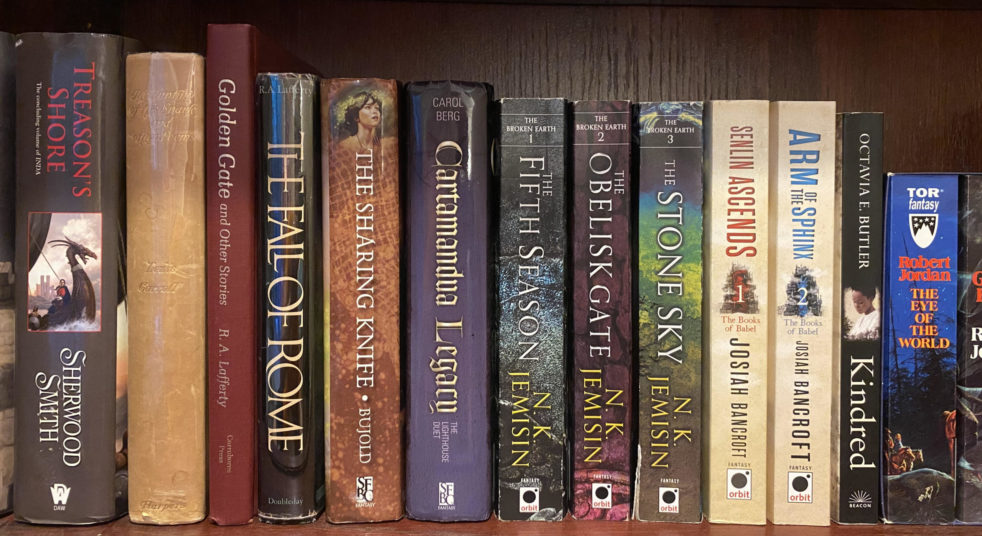
New epic fantasies always give me more apprehension than any other book. The ones that hit tend to really hit, and secondary world fantasy series dominate my all-time favorites list. But they try to accomplish so much that it’s easy to get bogged down in the setup, and I DNF epics more than anything else. But Rebecca Roanhorse’s new pre-Columbian epic has been getting a lot of good press, so with much trepidation, I decided to give Black Sun a shot. It didn’t take me very long to realize I shouldn’t have worried.
Keeping with genre conventions, Black Sun features four different perspective characters, all with their own backgrounds and goals. Serapio’s mother blinded him and carved his flesh in hopes that he would be the vessel of the Crow God, to return to the holy city of Tova on the day of black sun. Xiala comes from the mysterious Teek homeland in the sea to the East, and with her sea-calming magic, she is tasked with sailing Serapio through dangerous waters to meet his fate. Meanwhile, in Tova, Naranpa has risen to the highest position in the land, that of Sun Priest, but still fights factions struggling for power both within and outside of the priesthood, in addition to lingering prejudices that stem from her birth in the poorest district of the city. Those three alternate perspectives until the introduction of a fourth major character, Okoa, son of the matron of the Carrion Crow clan, who is thrown into the middle of these and other machinations and has to try to navigate uncertain waters to protect his family and his clan.
While Black Sun does have a climax that resolves major arcs–not always a guarantee in this subgenre–it is very much a first book in an epic series, in that it primarily sets up a world and characters for future action. And it does so very well, with one of the smoothest on-ramps I’ve seen in the genre. This is a subgenre known for door-stopping tomes, but Black Sun comes in under half the length of the openers to some of the longer-running series. Furthermore, Roanhorse writes in a natural, free-flowing style that makes the often-dense sections of worldbuilding or character introduction fly by as quickly as your average climactic action scenes. I was interested in three of the main characters after just one or two perspective chapters, and the fourth well before the novel’s halfway point.
Black Sun succeeds wildly as a setup book. It delivers compelling characters and a fascinating world conveyed in smooth, addictive prose. Its climax leaves so many possibilities open, with every major character in a position that is interesting without leaving an obvious next step. And not only do I not know what the characters are going to do next, I don’t even know which characters I’m cheering for–Roanhorse portrays four compelling characters whose interests conflict without telling the reader who is the hero and who is the villain, which leaves the possibilities even more open for book two. She does paint some broad strokes about how the world is changing, but so many of the details that make a reader invest are left for the future that I can’t wait to read more.
That said, the book’s strength as a setup can be a weakness as an individual series entry. In a series that is meant to be read as a unit, it’s hard for the first book to stand out without either a twist that reorients the reader’s perspective on the action or a hard-won victory that feels like significant progress has been made toward an ultimate goal. And significant progress is made in Black Sun–important things happen in this book! But the climax almost feels perfunctory, something that needs to be completed to set up further action but not something important in its own right. The plot moves, but it may move so quickly at the end that it doesn’t hit as hard as it should. Additionally, much of the conflict is driven by Serapio and Xiala racing the clock to reach Tova by the appointed time, but the book provides no real explanation for Serapio’s travels being behind schedule in the first place, making the time crunch feel contrived to bring two key characters together. On the plus side, it’s not a plot hole that affects anything going forward, and my excitement for book two is undiminished. On the minus side, it did leave me asking “why exactly are they in this mess right now” a few times during the reading.
Recommended if you like: easy-to-read epic fantasy, non-European worldbuilding, uncertainty about who are the heroes and who are the villains.
Overall rating: 15 of Tar Vol’s 20. Four stars on Goodreads.
